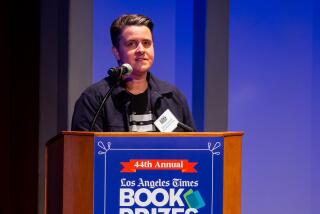Review: âChrist Actuallyâ argues for belief through imitation
Advent is upon us. Just days from now Christ will again be born. Can you believe it? Really, can you believe it?
Christian writers and other authors taking up the figure known as the Christ often find themselves haunted â or, if youâll have no truck with holy ghosts, challenged â by Flannery OâConnorâs ambition âto make belief believable.â Doing so in America was difficult when OâConnor first presented this notion in 1963, and it sometimes seems impossible now that Godâs disappearance feels so complete. And yet there are those of us, writers of fiction and nonfiction alike, who continue to try to find and then reveal a Christ someone can really believe in. Often we fail.
Iâm convinced, for instance, by recent arguments, notably one by writer Paul Elie, that most contemporary novels fail to âgrant belief any explanatory powerâ and thus refuse one sense of âthe fullness of life.â Arguably the most popular Christian factual writing in recent years, âHeaven Is for Real,â recounts a childâs round trip to heaven, where Jesus keeps a rainbow horse. Another popular and perhaps more believable factual approach involves academics â like Reza Aslan in âZealot: The Life and Times of Jesus of Nazarethâ â uncovering and reconstructing the Jesus of history and not the Christ of Christianity.
For all its merits, this approach typically abandons the question of religious belief, and in doing so, says Catholic writer James Carroll, ignores the historical reality of Christâs impact over the centuries. Because despite the successful storytelling approach of Aslan and others committed to seeing Jesus the man as âsomeone worth believing in,â Carroll argues in his new book, âChrist Actually: The Son of God for the Secular Age,â that itâs hard to imagine anyone would still think much about him were it not for the âtwo-thousand-year-old divinity claimâ that puts Jesus in our lives today. And nothing but our own religionlessness would make necessary or believable Carrollâs new book.
The problem is declared in the subtitle: We live in âa secular age.â But the question at the heart of this book is far more complicated than typical challenges to faith issued by nonbelievers. Itâs easy to dismiss Jesusâ rainbow horse. Itâs less easy to dismiss the Christ who comforts the afflicted, feeds the poor or stands witness against the apocalyptic promise of the atom bomb.
Itâs the bookâs greatest virtue that Carroll (Boston Globe columnist and author of âConstantineâs Sword,â among others) can present all these real-world possibilities for Christ alongside his lifetimeâs work in theology, historical research and biblical criticism.
âChrist Actuallyâ is about the birth of Christianity and the enduring role of Christ in light of the related moral catastrophes of war and genocide. In writing ancient history, Carroll ultimately eschews the search for the historical Jesus, knowing well that his belief, like all belief, distorts this subject more than most. He quotes theologian Elisabeth SchĂźssler Fiorenza â âScholars inescapably fashion the Historical-Jesus in their own image and likenessâ â before making plain that his own âreconstruction aims at a retrieval of Jesus as a true figure of peace and authentic justice.â (By contrast, for instance, Aslanâs portrait of Jesus in âZealotâ emphasizes his seditious kingly ambitions.)
Carrollâs vivid reconstruction of Roman-occupied Palestine presents a context for his version of Jesus. Whatâs come down through history as the Jewish War, as recorded by Josephus, is the apocalyptic lens through which the Gospel writers saw this 1st century Jewish prophet. Untold numbers of Jews were slaughtered in this ancient genocide; Jerusalem was destroyed. The Gospels are war literature. And Carroll reads them as such as a way to repair our understanding of Jesusâ essential Judaism, not only as a man committed to the Land (Eretz Yisrael) and the Temple but also as Christ, who was raised up by God according to the Jewish Scriptures.
But for all this historical fidelity, Carrollâs writing is also thoroughly modern and devotional. His notion of Christ for today depends on taking seriously the possibility that ours is now a âreligionless world.â This phrase comes from Dietrich Bonhoeffer, a Lutheran theologian and minister imprisoned and killed by the Nazis for his role in an assassination plot against Hitler. Bonhoefferâs Christ is difficult to dismiss.
And Carrollâs central question too comes from Bonhoeffer, whose theological project to salvage Christianity from the genocide at the middle of the 20th century, was left undone after his death in 1944. In letters sent from prison â themselves war literature â Bonhoeffer was, Carroll recalls, âgroping for words to express what remained an unspeakable experience.â Hiroshima, which Bonhoeffer would not live to see, is equally unspeakable and, for Carroll, completes the âdouble-barreled moral problem of our age.â
Weeks before he was hanged, Bonhoeffer wrote to a dear friend, âWhat is bothering me incessantly is the question â Who Christ actually is for us today?â For Carroll, Bonhoeffer himself gives us an answer loud and clear: With his life, facing down a genocidal power, he modeled Christ.
âImitation,â Carroll contends, âcan make us more than human.â And while the Christian devotional practice may have its roots in Thomas Ă Kempisâ 15th century handbook âImitation of Christ,â Carroll reminds us that âfrom the start, those who fell under his spell understood that being like Jesus was the only point.â Through imitation we transcend ourselves. Offering the further examples of humanitarian Dr. Albert Schweitzer and pacifist Dorothy Day, Carroll argues that the imitation of Christ is one truly viable way that remains to make belief believable.
In their moments, believers like Bonhoeffer and, later, Day, whose very lives opposed the infernality of war, groped for words that might give Christ some meaning amid the ruins of Christendom. Carroll gropes too and well. But there are no words as powerful as our human lives. Carroll knows this. It is his final word. And for Christians, he concludes, the fullness of their lives remains Christâs only hope.
Korb is the author of several books, including âLife in Year One: What the World Was Like in First-Century Palestine.â
Christ Actually
The Son of God for the Secular Age
James Carroll
Viking: 368 pp., $30
More to Read
Sign up for our Book Club newsletter
Get the latest news, events and more from the Los Angeles Times Book Club, and help us get L.A. reading and talking.
You may occasionally receive promotional content from the Los Angeles Times.







